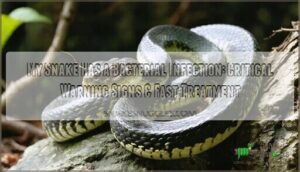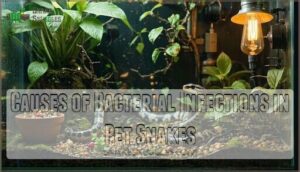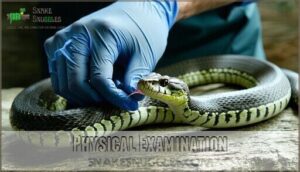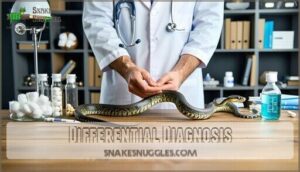This site is supported by our readers. We may earn a commission, at no cost to you, if you purchase through links.
 If you suspect your snake has a bacterial infection, you’re dealing with a serious health emergency that requires immediate veterinary attention.
If you suspect your snake has a bacterial infection, you’re dealing with a serious health emergency that requires immediate veterinary attention.
Common signs include skin lesions, respiratory distress, lethargy, loss of appetite, unusual discharge, and behavioral changes.
Don’t wait—bacterial infections can quickly turn life-threatening. Poor husbandry, stress, and wounds often trigger these infections.
Your vet will need to perform tests and prescribe antibiotics. While waiting for treatment, maintain proper temperature and humidity levels in the enclosure.
Quick action makes all the difference between recovery and tragedy. Understanding the specific warning signs can help you catch infections before they become critical.
Table Of Contents
- Key Takeaways
- Common Bacterial Infections in Snakes
- Recognizing Symptoms of Bacterial Infections in Snakes
- Causes of Bacterial Infections in Pet Snakes
- Diagnosing Bacterial Infections in Snakes
- Treatment Options for Snake Bacterial Infections
- Preventing Bacterial Infections in Pet Snakes
- Complications of Untreated Snake Bacterial Infections
- Recovering From a Bacterial Infection
- Specific Bacterial Pathogens Affecting Snakes
- When to Seek Emergency Veterinary Care
- Frequently Asked Questions (FAQs)
- Do snakes carry salmonella?
- What diseases do snakes have?
- What causes respiratory infections in snakes?
- Why does my snake have a sinus infection?
- What is bacterial skin infection in snakes?
- Can snakes cause skin infections?
- How to treat bacterial infection in snakes?
- What does an infection look like on a snake?
- What is a common bacterial disease in reptiles?
- Will a snake eat if it has a respiratory infection?
- Conclusion
Key Takeaways
- Act immediately when you spot symptoms – bacterial infections in snakes can progress from minor skin issues to life-threatening septicemia within hours, making early detection and prompt veterinary care critical for survival.
- Don’t attempt home treatment – bacterial infections require prescription antibiotics based on laboratory culture results, plus professional supportive care like fluid therapy and wound management that you can’t provide at home.
- Fix your husbandry practices – poor sanitation, incorrect temperatures, high humidity, and contaminated substrates create perfect breeding grounds for harmful bacteria, so maintain clean enclosures and proper environmental conditions.
- Monitor for emergency signs – severe respiratory distress, open-mouth breathing, complete loss of appetite, neurological symptoms, or rapid deterioration means you need emergency veterinary care immediately to prevent organ failure.
Common Bacterial Infections in Snakes
When you spot unusual symptoms in your snake, bacterial infections are often the culprit behind the concerning changes.
These infections range from skin conditions like ulcerative dermatitis to serious systemic diseases such as septicemia that can threaten your snake’s life.
Septicemia
When septicemia strikes your snake, you’re dealing with blood poisoning that spreads bacterial toxins throughout its entire system. This systemic infection can lead to fatal outcomes if left untreated.
Your snake’s immune system becomes overwhelmed as bacteria multiply in the bloodstream. Watch for these sepsis symptoms that signal danger:
- Extreme lethargy and weakness
- Complete loss of appetite lasting several days
- Small red dots or patches appearing on the skin
Snake septicemia requires immediate veterinary intervention. Blood tests will confirm the bacterial infection, and aggressive antibiotic treatment becomes essential. Without prompt infection treatment, this condition progresses rapidly and can result in organ failure within days.
Ulcerative Dermatitis
Ulcerative dermatitis transforms your snake’s skin into an inflamed, painful mess. This bacterial infection creates red, angry lesions that can develop into open wounds and fluid-filled blisters.
Poor sanitation and excessive humidity create perfect conditions for harmful bacteria to thrive. You’ll notice lifting scales, unusual discoloration, and areas where the skin looks damaged or infected.
Scale damage from this condition can lead to secondary complications if left untreated. Proper wound healing requires immediate veterinary attention and antibiotic therapy.
Infectious Stomatitis (Mouth Rot)
While ulcerative dermatitis affects your snake’s skin, infectious stomatitis targets the mouth.
You’ll spot this bacterial infection by checking for red, swollen gums and that telltale cheesy discharge around the teeth. Poor husbandry creates perfect conditions for mouth rot to flourish in your pet’s oral cavity.
Key warning signs of infectious stomatitis include:
- Thick, cottage cheese-like discharge coating the mouth
- Red, inflamed gums that appear swollen or irritated
- Open-mouth breathing as your snake struggles with oral discomfort
- Reluctance to eat due to painful oral lesions
This stomatitis requires immediate veterinary attention since bacterial infection can spread quickly throughout your snake’s system.
Pneumonia
Unlike mouth rot, which affects the oral cavity, pneumonia strikes your snake’s respiratory system with devastating force.
This bacterial infection transforms your pet’s lungs into a breeding ground for dangerous pathogens, creating a life-threatening emergency that demands immediate attention.
When bacteria invade your snake’s respiratory tract, breathing becomes a struggle.
You’ll notice labored breathing, open-mouth gasping, and thick nasal discharge.
These symptoms signal serious lung infection requiring urgent veterinary intervention.
| Symptom | Description |
|---|---|
| Labored breathing | Visible effort with each breath |
| Open-mouth breathing | Gaping mouth while resting |
| Nasal discharge | Thick, colored mucus from nostrils |
| Wheezing sounds | Audible respiratory distress |
| Reduced activity | Lethargy from breathing difficulty |
Chest X-rays reveal the extent of lung damage, while antibiotic therapy targets the bacterial infection.
Without treatment, respiratory failure becomes inevitable, making early intervention absolutely critical for your snake’s survival.
Abscesses
Looking at your snake, those firm lumps under the skin aren’t just bumps—they’re abscesses that need your attention fast.
These bacterial abscess formations develop when bacteria invade through wounds or bites, creating pockets of infection that can spread if left untreated.
Snake abscess symptoms you’ll notice:
- Firm, swollen lumps under the skin
- Common locations include mouth, neck, and body areas
- Pain causing behavioral changes or decreased activity
- Potential drainage of thick, cheesy material from the site
Infected abscess cases require immediate veterinary care for proper abscess treatment. Your vet will likely prescribe antibiotic therapy after draining the abscess and removing infected tissue.
Abscess care involves keeping the area clean while monitoring for signs of snake bacterial infections spreading to other body parts.
Recognizing Symptoms of Bacterial Infections in Snakes
When your snake shows signs of bacterial infection, you need to act fast—these symptoms can escalate quickly from minor irritation to life-threatening sepsis.
Recognizing early warning signs like skin changes, breathing problems, and behavioral shifts will help you get your snake the veterinary care it needs before the infection spreads throughout its body.
Skin Lesions and Discoloration
Your snake’s skin tells a story about its health. When bacterial infections strike, you’ll notice unusual patches, redness, or discoloration that wasn’t there before.
Look for blisters, ulcers, or scales that appear loose or raised. These skin lesions often start small but spread quickly without treatment.
Scale issues like erosion or color changes signal trouble brewing underneath. Bacterial skin infections need prompt attention – they won’t heal on their own and can lead to serious complications like septicemia.
It’s vital to recognize early signs of infection to prevent reptile health issues that can threaten your snake’s life.
Respiratory Distress
Several warning signs indicate respiratory distress in your snake. Wheezing sounds and gasping behavior are immediate red flags.
Watch for open mouth breathing, which snakes rarely do normally. Labored breathing patterns suggest serious trouble.
Bubbles around the nostrils signal potential respiratory infection. These symptoms can escalate to respiratory failure if untreated.
Bacterial infections often target the respiratory system, making prompt veterinary care essential for your snake’s survival.
Lethargy and Loss of Appetite
When your snake shows Snake Lethargy and Appetite Loss, bacterial infections often weaken their immune system.
These symptoms signal potential health issues requiring attention:
- Dehydration Signs – sunken eyes and dry mouth
- Poor Nutrition – refusing favorite foods consistently
- Weak Immune responses to environmental changes
- Behavioral changes – hiding more than usual
Bacterial infection causes systemic weakness, making snakes appear sluggish and uninterested in food.
Monitor these patterns closely, as antibiotic therapy may be necessary for recovery.
Swelling and Lumps
When examining your snake, firm lumps under the skin signal trouble.
These bacterial abscesses contain thick, cheesy material that screams infection. Common spots include the mouth, neck, and body areas.
Swelling causes range from untreated wounds to poor husbandry. Don’t ignore these infection signs – they’re your snake’s SOS signal.
Bacterial abscesses need immediate veterinary attention for proper lump removal and abscess care to prevent serious complications.
Abnormal Discharge
Watch for unusual discharge from your snake’s mouth or cloaca.
Abnormal discharge signals bacterial infection when you notice changes in color, consistency, or odor.
Mouth rot produces thick, cheesy secretions, while septicemia causes bloody discharge.
These infection symptoms require immediate diagnostic tests and treatment options to prevent systemic spread.
Causes of Bacterial Infections in Pet Snakes
Understanding what causes bacterial infections in your snake is essential for prevention and treatment.
These infections typically stem from five main sources: poor husbandry practices, stress-weakened immune systems, trauma that creates entry points for bacteria, environmental contaminants, and secondary infections from other diseases.
Poor Husbandry Practices
Poor husbandry practices create the perfect storm for snake bacterial infections. Dirty enclosures with inadequate ventilation trap harmful bacteria, while improper substrate retains moisture and waste. Incorrect temperature regulation weakens your snake’s immune system, making bacterial disease more likely.
Here’s what goes wrong most often:
- Poor sanitation – failing to remove waste and uneaten food promptly
- Inadequate ventilation – allowing stagnant air and humidity buildup
- Wrong substrate choices – using materials that hold excessive moisture
These snake health issues stem from basic husbandry mistakes that create bacterial breeding grounds. Regular checks for snake health issues can help prevent common diseases.
Stress and Weakened Immune System
Under stress, your snake’s immune system weakens, creating perfect conditions for bacterial infections.
Think of stress as opening the door for harmful bacteria to waltz right in.
Common stressors that compromise your snake’s defenses:
- Handling Techniques: Excessive or rough handling disrupts natural behaviors
- Enclosure Stressors: Inconsistent temperatures, poor lighting, or inadequate hiding spots
- Dietary Impact: Irregular feeding schedules or nutritionally poor prey items
- Quarantine Importance: Overcrowding or introducing new animals without proper isolation protocols
Trauma and Wounds
Physical wounds create perfect entry points for bacterial infections.
Prey bites from live feeding pose serious risks, while enclosure hazards like rough surfaces or sharp decorations can cause cuts.
Handling injuries happen when snakes struggle during routine care.
Shedding complications leave vulnerable skin exposed to bacteria.
Any break in your snake’s skin becomes a highway for germs.
Proper wound care prevents minor injuries from becoming major bacterial infections.
Environmental Contaminants
Your snake’s home can become a breeding ground for dangerous bacteria through contaminated water quality, dirty substrate bacteria, and harsh cleaning products.
Even decorative items harbor harmful microorganisms.
Fungal growth thrives in poorly ventilated enclosures, while airborne particles circulate pathogens.
Snake cage hygiene directly impacts your pet’s health—neglected environmental contaminants create perfect conditions for bacterial infections to take hold.
Secondary Infections From Other Diseases
When mite infestations or parasitic complications hit your snake, they’re like opening the door for unwelcome guests.
These primary issues create immunosuppression risks that leave your pet vulnerable to bacterial infections.
Viral susceptibility and fungal infections further compromise your snake’s weakened immune system.
Secondary infections develop because the original problem has already worn down your snake’s natural defenses, making snake bacterial infections harder to treat effectively.
Diagnosing Bacterial Infections in Snakes
When your snake shows signs of bacterial infection, you’ll need a veterinarian to conduct a thorough physical examination and run specific diagnostic tests.
Your vet will use laboratory cultures, blood work, and sometimes imaging to identify the exact bacteria and determine the best treatment approach.
Physical Examination
Once you’ve identified potential causes, your snake vet will conduct a thorough physical examination to detect bacterial infection signs.
This hands-on assessment helps pinpoint problems before they worsen.
During the examination, your veterinarian will systematically evaluate your snake’s condition:
- Skin Assessment: Checking for lesions, discoloration, blisters, or unusual patches that indicate infection
- Mouth Examination: Looking for redness, swelling, or discharge suggesting infectious stomatitis
- Behavioral Observation: Noting lethargy, appetite changes, or abnormal positioning that signals illness.
The vet will also perform respiratory checks and lump palpation to identify abscesses or swelling.
This thorough evaluation guides the differential diagnosis process before laboratory tests.
Laboratory Tests
Laboratory tests reveal what your eyes can’t see.
Blood work detects infection markers like elevated white blood cell counts.
Culture tests identify specific bacterial pathogens and guide antibiotic treatment selection.
Biopsy results examine tissue samples for inflammation and bacterial presence.
PCR testing offers high sensitivity for detecting snake bacterial pathogens at low concentrations.
These laboratory tests provide concrete evidence for accurate snake health diagnostics and targeted treatment plans.
They are essential for accurate snake health diagnostics.
Imaging Techniques
Beyond bloodwork and cultures, veterinarians rely on advanced imaging techniques to visualize internal bacterial infections that aren’t visible externally.
These diagnostic tools provide detailed views of your snake’s anatomy, helping pinpoint infection locations and severity.
- X-rays (Radiographs): Reveal pneumonia, internal abscesses, and bone infections throughout your snake’s body
- Ultrasounds: Show real-time images of fluid-filled pockets and organ abnormalities in soft tissues
- CT scans: Create cross-sectional views for complex infections affecting multiple body systems
- Endoscopy: Allow direct visualization of respiratory tract and internal surfaces using fiber-optic cameras
Differential Diagnosis
Your vet runs Diagnostic Tests to rule out other conditions that mimic bacterial infection symptoms.
They’ll examine your snake’s Medical History and Physical Exam findings, comparing Lab Results against diseases like scale rot, adenovirus, and fungal infections.
This differential diagnosis process helps septicemia or other snake bacterial infections get properly identified.
Infection Signs help narrow down the true culprit causing your pet’s illness.
Treatment Options for Snake Bacterial Infections
Once you’ve confirmed your snake has a bacterial infection, swift treatment becomes critical to prevent serious complications.
Your veterinarian will design a thorough treatment plan that typically includes antibiotic therapy, supportive care, and environmental corrections to eliminate the infection and restore your snake’s health.
Antibiotic Therapy
Once your vet confirms the bacterial infection, you’ll need antibiotic therapy customized to your snake’s specific needs.
Dose calculation depends on your pet’s weight and the bacteria involved. Treatment duration typically spans 7-14 days, but bacterial susceptibility testing guides the best choice.
Watch for medication side effects like appetite loss during antibiotic administration.
It’s vital to understand snake antibiotic options to guarantee effective treatment.
Supportive Care and Fluid Therapy
While antibiotics tackle the bacterial infection, your snake needs supportive care and fluid therapy to recover fully.
Dehydration weakens your pet’s immune system, making recovery slower and more difficult.
- Subcutaneous fluids – Administered under the skin to restore hydration levels quickly
- Electrolyte balance – Oral solutions help maintain essential minerals during illness
- Nutrient support – Force-feeding ensures your snake gets necessary nutrition when appetite’s gone
Proper bacterial infection treatment is essential for a successful recovery.
Wound Management and Debridement
Proper wound cleaning forms the foundation of effective infection control in snake bacterial infections.
You’ll start by flushing the affected area with sterile saline solution, removing debris and bacteria that could worsen the condition.
Debridement techniques involve carefully removing dead or damaged tissue using sterile instruments, creating a clean environment for tissue repair.
This process prevents Aeromonas species and other pathogens from establishing deeper infections.
Always disinfect your tools between treatments and monitor the wound daily for signs of improvement or deterioration requiring surgical intervention.
Surgical Intervention
When standard wound management isn’t enough, surgical intervention becomes your snake’s best shot at recovery.
Your vet will use surgical tools to perform abscess removal and tissue repair, ensuring proper wound closure afterward.
Here’s what surgery might involve:
- Draining infected pus from deep abscesses
- Removing dead or necrotic tissue completely
- Treating bone infections like osteomyelitis
- Repairing damaged organs or structures
- Installing drainage tubes if needed
Post op care requires dedicated monitoring and antibiotic therapy continuation.
Correcting Environmental Factors
Beyond surgical procedures, your snake’s living space needs immediate attention to fight infection and prevent reoccurrence.
Environmental adjustments work like medicine for your pet’s recovery.
Temperature control and humidity management form the foundation of healing.
Clean your snake enclosure thoroughly, removing contaminated substrate and disinfecting all surfaces.
Improve ventilation systems to prevent stagnant air that harbors bacteria.
Consider these emotional impacts of poor snake environment sanitation:
- Your snake suffers silently in contaminated conditions
- Delayed treatment means prolonged pain and stress
- Poor snake humidity control leads to recurring infections
- Inadequate snake temperature control weakens immune defenses
Preventing Bacterial Infections in Pet Snakes
Prevention is your best defense against bacterial infections in snakes. By maintaining proper husbandry and environmental conditions, you can substantially reduce your snake’s risk of developing these serious health problems.
Proper Enclosure Hygiene
Your snake’s health hinges on rigorous sanitation protocols and consistent cleaning schedules. Weekly substrate changes prevent bacterial buildup, while proper ventilation systems control moisture levels.
Substrate selection affects humidity control – avoid overly moist materials that harbor pathogens. Effective reptile cleaning supply management is essential for maintaining a healthy environment.
| Cleaning Task | Frequency | Method |
|---|---|---|
| Substrate replacement | Weekly | Remove all bedding, disinfect base |
| Water bowl cleaning | Every 3 days | Scrub with reptile-safe disinfectant |
| Spot cleaning waste | Immediately | Remove feces/urates with tongs |
| Deep enclosure sanitization | Monthly | Full disassembly, thorough disinfection |
| Hide box cleaning | Bi-weekly | Wash with mild soap, rinse completely |
Maintaining Optimal Environmental Conditions
Creating the perfect snake environment prevents bacterial infections before they start.
Your snake’s health depends on getting these five conditions right:
- Temperature Control: Maintain proper thermal gradients with basking spots and cool zones
- Humidity Levels: Keep moisture between species-appropriate ranges using hygrometers
- Enclosure Size: Provide adequate space for natural behaviors and movement
- Ventilation Systems: Guarantee proper airflow to prevent stagnant air and bacterial growth
- Substrate Quality: Use clean, appropriate bedding that doesn’t retain excess moisture
Monitor snake tank conditions daily.
Poor snake environment maintenance creates breeding grounds for harmful bacteria that cause infections.
Regular Health Check-ups
With preventive measures in place, annual exams and regular health checkups become your snake’s best defense against bacterial infections.
Veterinary care professionals can detect early warning signs before they escalate into serious problems.
| Checkup Component | Frequency |
|---|---|
| Physical examination | Annually |
| Fecal parasite screening | Every 6-12 months |
| Weight monitoring | Monthly at home |
| Behavioral assessment | Ongoing observation |
| Health monitoring review | Each visit |
Snake veterinary care includes thorough evaluations of skin condition, respiratory function, and overall body condition.
These snake health checkups help identify potential issues early, making treatment more effective and less costly than emergency interventions.
Proper Nutrition and Hydration
A balanced diet forms your snake’s first line of defense against bacterial infections.
You’ll strengthen your snake’s immune system by offering appropriate prey sizes and maintaining fresh water daily.
Quality food quality and proper hydration tips support complete snake health.
Consider nutrient supplements when recommended by your veterinarian to guarantee complete snake nutrition and resilient infection resistance.
Stress Reduction Techniques
Managing stress reduction effectively prevents bacterial infections by strengthening your snake’s immune system through proper environmental enrichment and handling techniques.
Temperature control and humidity management create ideal conditions that reduce physiological stress. Consistent environmental parameters prevent immune system suppression that makes snakes vulnerable to bacterial pathogens.
Stress management involves three key approaches:
- Environmental enrichment with multiple hiding spots, appropriate substrate, and climbing opportunities
- Handling techniques that minimize disturbance through gentle, infrequent contact sessions
- Calming aids like consistent lighting cycles and proper enclosure placement away from high-traffic areas
Complications of Untreated Snake Bacterial Infections
Left untreated, bacterial infections in snakes can quickly escalate from minor skin issues to life-threatening systemic conditions that affect multiple organ systems.
These complications range from localized abscesses spreading throughout the body to complete organ failure and potentially fatal septicemia.
Systemic Spread of Infection
When bacteria enter your snake’s bloodstream, the infection spreads throughout their body like dominoes falling.
This systemic infection overwhelms their immune response and creates dangerous sepsis risk.
Watch for these warning signs:
- Severe lethargy and weakness
- Complete loss of appetite
- Multiple swollen areas appearing
- Skin discoloration and abnormal patches
The bacterial load increases rapidly, causing organ damage as infection pathways spread through essential systems.
Your snake’s body can’t fight this systemic spread alone, and it is crucial to address the issue promptly to prevent further sepsis.
Organ Failure
When bacterial infections spread throughout your snake’s body, organ failure becomes a devastating reality.
Kidney damage and liver failure occur as toxins overwhelm these essential organs, while respiratory collapse and cardiac arrest follow quickly behind.
Multi organ failure creates a cascade where each system shuts down, making recovery nearly impossible without immediate veterinary intervention and aggressive treatment protocols.
Septicemia and Shock
When organ failure starts shutting down your snake’s body, septicemia and shock can quickly follow.
Your pet’s bloodstream becomes a highway for bacteria, spreading systemic infection throughout their entire system.
This blood infection overwhelms their immune response, leading to cardiovascular collapse and potentially fatal shock.
Watch for these emergency care warning signs:
- Extreme lethargy and unresponsiveness
- Rapid, shallow breathing patterns
- Cold body temperature despite proper heating
- Discolored or mottled skin patches
Sepsis prevention starts with early detection.
Shock treatment requires immediate veterinary intervention – don’t wait when you spot these symptoms.
Chronic Health Issues
When left untreated, bacterial infections can trigger chronic health issues that’ll plague your snake for months or years.
Your pet’s immune system becomes compromised, creating a vicious cycle where recurring infections become the norm.
Chronic care requires consistent health monitoring and disease management strategies.
Poor snake wellness leads to persistent respiratory problems, skin lesions, and digestive issues.
Longterm recovery demands dedicated reptile health maintenance and vigilant snake health oversight.
Potential for Zoonotic Transmission
When bacterial infections go untreated, you’re facing more than just your snake’s health crisis. Zoonotic transmission becomes a serious threat, putting you and your family at risk.
Up to 76% of snakes carry Salmonella, which causes salmonellosis in humans. These zoonotic diseases don’t stay contained to your pet.
Bacterial transfer happens through direct contact with infected snakes, contaminated surfaces, or bites. Poor infection control amplifies human risk exponentially. Children under five face the highest danger from snake bacterial infections.
Essential pet safety measures include:
- Thorough handwashing after every snake interaction
- Immediate disinfection of contaminated surfaces and equipment
- Never touching your face before cleaning hands
- Seeking medical attention for any snake bites or scratches.
Don’t let your snake’s bacterial infection become your family’s health emergency.
Recovering From a Bacterial Infection
Your snake’s recovery from bacterial infection requires careful monitoring and consistent veterinary follow-up to guarantee complete healing.
You’ll need to track specific health indicators while making necessary environmental adjustments to prevent reinfection and support your snake’s immune system recovery.
Monitoring Progress and Healing
Now you’ll watch for key Healing Signs during your snake’s recovery.
Track these vital indicators to confirm your bacterial infection treatment works effectively:
| Recovery Indicator | What Success Looks Like |
|---|---|
| Appetite Return | Snake accepts food within 1-2 weeks |
| Wound Closure | Lesions dry, scab, and heal completely |
| Activity Level | Normal movement and alertness returns |
Progress Tracking involves daily Health Checks during Recovery Time.
Document changes in your snake’s condition for followup veterinary care discussions.
Follow-up Veterinary Care
Schedule regular veterinary visits to track your snake’s recovery progress and confirm complete infection clearance.
Your vet will review medical records, adjust antibiotic treatment duration, and modify treatment plans based on healing response.
These essential follow ups provide veterinary consultation opportunities to discuss post care strategies and prevent future snake bacterial infections.
Consistent followup veterinary care maximizes your snake infection cure success rate.
Understanding snake health basics is vital for effective recovery and long-term snake well-being.
Adjusting Husbandry Practices
After bacterial infection recovery, systematically adjust your husbandry practices to prevent reinfection.
Focus on three key areas:
- Enclosure Cleaning – Implement weekly deep cleaning with reptile-safe disinfectants
- Humidity Control – Maintain species-appropriate levels using digital hygrometers
- Temperature Regulation – Verify gradient accuracy with calibrated thermometers
Proper substrate management and enhanced hygiene practices create essential environmental conditions that support your snake’s immune system and prevent future bacterial infections.
Regular use of effective reptile disinfectant solutions is vital for a healthy environment.
Rebuilding Immune System Strength
Strengthening your snake’s immune system after bacterial infection requires patience and strategic care.
Your pet’s body needs time to rebuild its natural defenses through proper nutrition therapy and stress management techniques.
- Immune Boosters: Provide high-quality prey items rich in vitamins A, C, and E to support cellular repair and immune function
- Probiotic Supplements: Add reptile-specific probiotics to restore healthy gut bacteria and enhance immune system support
- Environmental Enrichment: Create hiding spots and climbing opportunities to reduce stress and promote natural behaviors
- Stress Management: Maintain consistent temperatures and minimize handling during recovery to prevent immune system suppression
Long-term Health Considerations
Managing long-term health after bacterial infections requires consistent chronic care and vigilant health monitoring.
Your snake’s immune support depends on proper nutrition management and ideal husbandry practices.
Focus on disease prevention through regular veterinary checkups and environmental control.
Remember that infection prevention strengthens snake immunity naturally, ensuring your pet’s longterm health remains stable and resilient.
Specific Bacterial Pathogens Affecting Snakes
Understanding the specific bacteria behind your snake’s infection helps target treatment effectively. Five primary bacterial pathogens commonly affect snakes: Aeromonas, Pseudomonas, Citrobacter freundii, Mycobacterium, and Salmonella species.
Aeromonas Species
Your snake’s recovery hinges on identifying the bacterial culprit behind the infection. Aeromonas species thrive in aquatic environments and often affect snakes through contaminated water sources.
These bacterial strains cause severe symptoms including necrotic lesions and septicemia.
- Water Quality: Maintain pristine water conditions to prevent Aeromonas contamination
- Fish Connection: Avoid feeding fish from questionable sources that harbor Aeromonas shigelloides
- Aeromonas Prevention: Regular enclosure cleaning eliminates bacterial growth opportunities
Pseudomonas Species
Within moist environments, Pseudomonas species flourish and attack your snake’s skin and respiratory system.
These opportunistic bacteria cause stubborn infections requiring targeted antibiotic treatment. Bacterial resistance complicates treatment, making species identification vital for infection control.
Identifying bacterial infection signs is critical to prevent the spread of disease.
| Infection Type | Common Symptoms |
|---|---|
| Skin Infections | Red lesions, ulcers |
| Respiratory | Labored breathing, discharge |
| Septicemia | Lethargy, loss of appetite |
| Wound Infections | Swelling, pus formation |
Citrobacter Freundii
Citrobacter freundii poses a real threat to your snake’s health through opportunistic bacterial infections.
This gram-negative bacterium commonly causes septicemia and localized abscesses when your snake’s immune system weakens.
You’ll notice Citrobacter symptoms including skin lesions, respiratory distress, and lethargy.
Bacterial strains like C. freundii show increasing antibiotic resistance, making proper infection control essential.
Snake care requires immediate veterinary attention when you suspect reptile infection signs appear.
Mycobacterium Species
Mycobacterium species cause severe reptile infections known as snake TB.
These bacterial strains spread through contaminated environments and infected prey items.
Myco bacteria create granulomatous lesions in organs, making disease transmission particularly dangerous.
Snake pathogens like Mycobacterium require immediate veterinary attention since bacterial infections progress rapidly and can prove fatal without proper antibiotic treatment.
Salmonella Species
Understanding Salmonella species helps protect both you and your snake from serious health risks.
This bacterial infection creates significant zoonotic concerns through direct contact with infected animals.
- Salmonella Prevention: Wash hands thoroughly after handling your snake or cleaning its enclosure
- Bacterial Transmission: Occurs through fecal-oral contact and contaminated surfaces
- Zoonotic Risks: Over 70,000 Americans contract salmonellosis from reptiles annually
- Snake Hygiene: Regular enclosure cleaning reduces human exposure to dangerous bacteria
When to Seek Emergency Veterinary Care
Some bacterial infections in snakes can turn life-threatening within hours, making quick recognition of emergency symptoms essential for your pet’s survival.
You’ll need immediate veterinary care when you notice severe breathing problems, sudden weakness, or signs that the infection has spread throughout your snake’s body, which can be a clear indication of a life-threatening condition.
Severe Respiratory Distress
Severe respiratory distress signals a medical emergency requiring immediate veterinary attention.
Open-mouth breathing, wheezing, and breathing difficulties indicate potential lung infection or airway obstruction.
Bacterial infection can cause respiratory failure within hours.
Your snake needs oxygen therapy and antibiotics to survive respiratory disease.
Don’t wait—snake respiratory issues progress rapidly without treatment.
Rapid Deterioration of Condition
When your snake’s health takes a sudden decline, you’re facing a medical emergency that demands critical care.
Rapid deterioration signals potential septicemia or systemic bacterial infection spreading throughout your pet’s body.
Emergency interventions and intensive therapy become essential when your snake shows dramatic worsening within hours—difficulty breathing escalates to respiratory distress, lethargy becomes complete unresponsiveness, or multiple symptoms appear simultaneously.
Rapid diagnosis and immediate antibiotic treatment can mean the difference between recovery and loss.
Recognizing snake health issues is vital in preventing such emergencies and ensuring timely veterinary care.
Neurological Symptoms
Beyond physical symptoms, bacterial infections can attack your snake’s nervous system, causing brain damage and nerve issues that demand immediate veterinary attention.
When bacterial toxins reach the nervous system, they trigger seizure activity and muscle weakness that can progress to paralysis within hours.
Watch for these neurological symptoms in snake bacterial infections:
- Seizure activity: Uncontrolled convulsions or trembling episodes
- Muscle weakness: Inability to coil properly or support body weight
- Abnormal posturing: Head tilting, corkscrewing, or unusual body positioning
- Paralysis: Complete loss of movement in body segments
Septicemia often causes these severe neurological complications when bacterial toxins cross into brain tissue. Don’t wait—these symptoms signal potential permanent nerve damage.
Refusal to Eat for Extended Periods
When your snake stops eating, it’s like a red flag waving in the wind.
This feeding refusal signals serious trouble that demands immediate veterinary attention.
Appetite Loss in snakes can indicate bacterial infection, septicemia, or other life-threatening conditions that worsen rapidly without treatment.
Extended periods without food create dangerous Starvation Risks and Malnutrition Effects that compromise your snake’s already weakened immune system.
Bacterial infections often trigger this refusal to eat, making it both a symptom and a complicating factor in recovery.
| Duration Without Food | Risk Level |
|---|---|
| 1-2 weeks | Monitor closely |
| 3-4 weeks | Veterinary consultation |
| 5+ weeks | Emergency care needed |
| With other symptoms | Immediate attention |
Don’t wait for Eating Disorders to resolve naturally.
Snake health deteriorates quickly when Feeding Issues persist alongside bacterial infections, creating a dangerous cycle where illness prevents eating and starvation worsens the infection.
Signs of Systemic Infection or Sepsis
Recognizing systemic infection or sepsis in snakes requires immediate action.
These bacterial toxins can quickly overwhelm your snake’s system, leading to septicemia and potentially fatal outcomes.
- Lethargy and complete loss of appetite – Your snake won’t move or eat
- Severe respiratory distress – Labored breathing, open-mouth breathing, wheezing
- Red skin dots or discoloration – Signs of infection spread throughout the body
- Neurological symptoms – Tremors, loss of coordination, abnormal posturing
Frequently Asked Questions (FAQs)
Do snakes carry salmonella?
Yes, your scaly friend can harbor salmonella naturally without showing symptoms.
This "hidden hitchhiker" spreads through contaminated water, substrate, and direct contact.
You’ll want to wash hands thoroughly after handling to prevent transmission to yourself.
What diseases do snakes have?
Your snake could face several diseases including bacterial infections like septicemia and mouth rot, parasites such as mites and internal worms.
Respiratory infections, blister disease, and serious viral conditions like inclusion body disease are also potential health issues for your snake.
What causes respiratory infections in snakes?
What triggers these respiratory nightmares in your scaly friend?
Poor husbandry creates the perfect storm – incorrect temperatures, high humidity, dirty enclosures, and stress weaken your snake’s immune system, allowing bacteria to invade the lungs.
Why does my snake have a sinus infection?
Your snake’s sinus infection stems from bacterial overgrowth in nasal passages, typically triggered by poor husbandry conditions.
Like incorrect humidity levels, dirty substrate, or inadequate ventilation creating ideal bacterial breeding grounds.
What is bacterial skin infection in snakes?
Like a storm brewing under the surface, bacterial skin infections create visible chaos on your snake’s exterior.
You’ll notice red, inflamed patches, open wounds, or blisters that develop from poor husbandry conditions, high humidity, or contaminated environments requiring immediate veterinary attention.
Can snakes cause skin infections?
Reptiles naturally carry bacteria that can transfer to your skin through handling. You’ll face higher risk if you have open wounds, cuts, or compromised immunity when touching your snake.
How to treat bacterial infection in snakes?
Don’t let this curveball catch you off guard—bacterial infections need prompt veterinary attention.
You’ll require prescription antibiotics based on bacterial culture results, plus supportive care like fluid therapy and wound cleaning to restore your pet’s health.
What does an infection look like on a snake?
You’ll spot red, inflamed skin with open wounds, blisters, or unusual patches. Look for mouth swelling with cheesy discharge, firm lumps under skin, and breathing difficulties with nasal discharge.
What is a common bacterial disease in reptiles?
An ounce of prevention is worth a pound of cure" – infectious stomatitis (mouth rot) is the most common bacterial disease you’ll encounter in reptiles.
Causing redness, swelling, and cheesy discharge in your snake’s mouth.
Will a snake eat if it has a respiratory infection?
A snake with a respiratory infection will typically refuse food or eat much less than usual.
The infection causes discomfort and breathing difficulties, making your snake prioritize recovery over eating until symptoms improve.
Conclusion
A veterinarian diagnosed Jake’s ball python with pneumonia after the snake developed labored breathing and mouth breathing.
The bacterial infection required immediate antibiotic treatment and environmental adjustments to prevent fatal complications.
When you suspect your snake has a bacterial infection, time becomes critical, and early detection is key to determining survival outcomes.
Proper husbandry prevents most infections, but when they occur, swift action saves lives, so monitor your snake closely and maintain ideal conditions throughout treatment.
- https://www.merckvetmanual.com/exotic-and-laboratory-animals/reptiles/bacterial-diseases-of-reptiles
- https://www.healthline.com/health/abnormal-posturing
- https://www.petmd.com/reptile/care/evr_rp_how-can-i-tell-if-my-snake-sick
- https://vcahospitals.com/know-your-pet/snakes-diseases
- https://www.petcoach.co/article/egg-binding-dystocia-in-reptiles-causes-signs-diagnosis-tre/





















